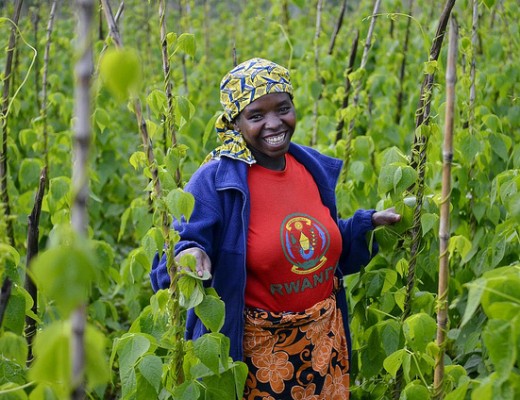Fin4Ag is an annual conference that brings together farmers, financiers, central bank governors, ICT entrepreneurs from African, Caribbean and Pacific (ACP) countries and elsewhere to address the challenges of financing agriculture and explore strategies for mobilizing finance to transform the sector in Africa and the developing world. Held July 14-18 in Nairobi, Kenya, Fin4Ag 2014 was organized by the ACP-EU Technical Centre for Agricultural and Rural Cooperation, African Rural and Agricultural Credit Association, Central Bank of Kenya and the Kenya School of Monetary Studies under the theme “Revolutionizing Finance for Agri-Value Chains.
At issue. Smallholder farmers, who make up the bulk of Africa’s agriculture sector, lack adequate access to finance. Commercial lenders argue that the risk of lending to farmers is too high. In Kenya, for example, less than 10 percent of farmers have access to formal credit. Ninety percent of the funds that go into African agriculture come from the farmers themselves. The credit void retards the sector’s modernization and expansion, and contributes to food insecurity.
The paradox. Africa spends $35 billion annually on food imports, when the continent has the land (some 700 million hectares of arable land, most of it uncultivated), resources, and workforce not only to fill the gap this import bill represents, but also to produce enough surplus for export to meet a growing global demand for food.
Models that work. Conference participants reflected on existing financing models that work in Africa and elsewhere.
Brazil. The use of Rural Product Notes, whereby farmers issue IOUs on the basis of future sales, for example of their cattle or crops, have been a massive boost to agriculture in Brazil. The IOUs, or Rural Product Notes, serve as a bond with which farmers pledge to deliver specified quantities of specific products, or cash, at an agreed place and time in return for up-front finance. These have proved highly effective for medium-sized commercial farmers – the sort of people who might have 100 head of cattle – but who don’t have the credit rating needed to attract big banks.” Variations on this theme – involving, for example, the bundling of the notes to sell to pension funds – are also proving viable.
Ethiopia. The Horn of Africa Risk Transfer for Adaptation project, an integrated risk management scheme developed by the Relief Society of Tigray (Ethiopia) and Oxfam America, helps Ethiopian farmers strengthen their food and income security through a combination of improved resource management, crop insurance, microcredit, and savings. The poorest farmers pay for insurance with their labor through building projects in their communities.
Kenya. The Netherlands East Africa Financial Sector Expertise Exchange Program (NEAFSEEP), a $10 million Dutch-Kenyan agri-finance initiative launched by a public-private partnership of the Embassy of the Netherlands in Nairobi, Financial Access Capital Partners and SCOPEinsight East Africa, so far has funded 12 projects.
Nigeria. The Nigerian Incentive-based Risk Sharing System for Agricultural Lending (NIRSAL) has spent some $350 million and leveraged $3.5 billion from banks to support agricultural value chains. In 2011, the proportion of bank lending to agriculture amounted to just 0.7 percent of total lending. Nigeria estimates that figure will have risen to 7.5 percent by the end of 2014. The Nigerian government also has provided fertilizer vouchers, which can be redeemed via mobile phone, to more than 8 million farmers.
Uganda. A credit guarantee scheme supported by the Rockefeller Foundation encourages banks to increase their lending to smallholders. As of July 2014, $500,000 provided by the foundation has helped to leverage over $20 million of agricultural lending.
Zimbabwe. The Zimbabwe Agricultural Development Trust Fund, a financial instrument set up with core funding from the Danish International Development Agency, is channeled through local banks, which lend money to smallholders at an interest rate of 11.5 percent, compared to 25 percent for commercial lending. So far, the $36 million fund has provided loans to 209 small and medium enterprises involved in agricultural value chains, involving some 26,000 smallholder farmers.
Conclusions
* Agriculture has been allowed to stay as part of the informal sector, as a sort of ‘charity case’ with all manner of tax exemptions. We need to examine how to encourage the informal sector to become part of the formal sector, and that will involve supporting value chains.” — Maria Kiwanuka, Uganda’s minister for finance and economic development.
* Farmers need to be seen as producers, as business people, rather than subsistence operators, and as a source of tax growth.
* Cease treating agriculture as a development program and treat it instead as the business it is. To this end, African governments must step in by using public money to leverage private capital.
* Farmers in rural areas must be educated in ways to leverage new technologies in order to improve their farming methods and practices.
* Finance for agriculture is a risk well worth taking for the wellbeing of African farmers, for the strength of their nations, and for the prosperity of the entire continent.
* Governments need to create an enabling environment to encourage financial institutions to work more closely with the agricultural sector.













